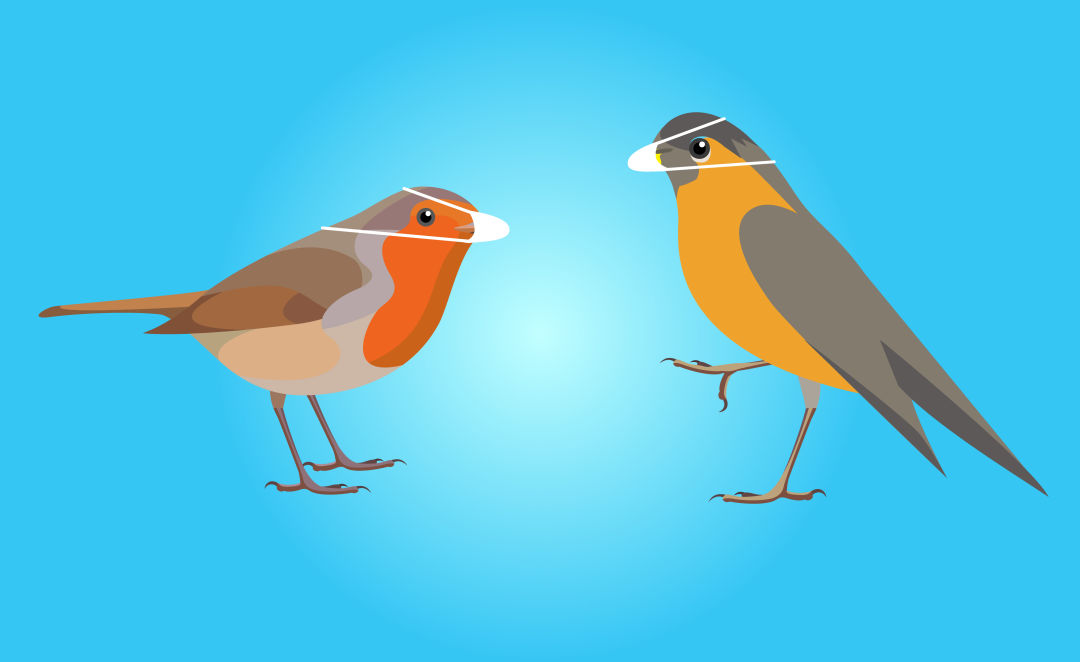A New Study Aims to Learn the Impacts of Social Distancing on Birds in the Pacific Northwest

The University of Washington Quantitative Ecology Lab is conducting a study on social distancing and its effect on birds in the Pacific Northwest. And it's asking volunteer citizen scientists to assist.
Image: Kas Tan/Shutterstock and Mike Novak
Olivia Sanderfoot is embarking on a year-long study on how social distancing affects birds of the Pacific Northwest. A researcher at the University of Washington Quantitative Ecology Lab, Sanderfoot is particularly interested in whether the region will see a decline in air and noise pollution—and what kind of an effect that will have on birds.
“If we see a decline in noise pollution, we might hear birds more often," she says. "That could be because birds are actually more active, or it might be because we can actually hear them, and that, I think, is a really interesting question to dig in to.”
The Pacific Northwest is home to more than 1,000 bird species.
Sometimes, they’re obvious, as in the murders of pitch-black crows that come swooping down from the purple-orange skies at dusk each winter for their annual roost, their cacophony of caws echoing off metal and glass and concrete in downtown.
Sometimes, they’re a bit more discreet, as in the American Robin that quietly picks out earthworms from the short grass, only to be seen if we’re keenly observing, looking for their burnt-orange chests on our morning walks.
As an ecologist, it’s part of Sanderfoot’s job to study how wildlife is influenced by people and their environment. And just in the last few weeks, a lot has changed. With the ongoing efforts to mitigate and contain the spread of COVID-19, Oregon and Washington—one of the country’s early hotspots for positive coronavirus cases—have implemented some form of a stay-at-home order. While social distancing (what the Oregon Health Authority now refers to as "physical distancing") has had tremendous economic, political, and social ramifications, Sanderfoot’s study concerns the ecological and environmental impact of these efforts, particularly on birds.
Originally, Sanderfoot had planned to use her doctoral research at UW to study the effects of prescribed burns on birds in eastern Washington. When prescribed burns in the region were suspended as a result of the pandemic, Sanderfoot pulled her work. As news about the the virus continued to unfold, she pivoted—instead focusing on a community science program through eBird, an online database of bird observations, to study the direct and indirect effect human social distancing measures have on birds in urban and suburban areas of the Pacific Northwest.
“I figured that there are a lot of people sitting at home looking for something to do, maybe something that makes them feel useful or empowered or inspired. I take so much hope and joy from my own birdwatching,” Sanderfoot says. “It’s been such a meaningful activity and hobby for me. I thought I could get others to share in that experience.”

Olivia Sanderfoot, a researcher at the University of Washington Ecology Lab, is conducting a study on how social distancing efforts affect bird activity. She was introduced to birding during her undergrad. "Somebody once told me that you don’t care about something until you name it. And I feel like that’s so true with birds," she says. "When you have that personal connection you just care so much more about what you’re seeing."
Image: Courtesy Olivia Sanderfoot
The UW study is asking for citizen scientists across the Pacific Northwest to monitor bird activity for a minimum of 10 minutes from their own backyard or green space without violating their respective state’s stay-at-home order. The more volunteers the study has, the more robust the data. As of Wednesday, April 8, the study has more than 260 volunteers, from absolute beginners to fellow ecology colleagues, eager to participate. The idea is for volunteers to conduct their surveys from the same location, recording each bird they see and hear each day for the spring season in 2020 and 2021, when—fingers crossed—enough data will have been gathered to be able to share.
As far as what she'll uncover, Sanderfoot has many hypotheses.
As health-damaging pollutants from traffic and other carbon emissions decline and air quality improves in some areas (as the Seattle Times recently reported), birds might become more active or visit places that were previously undesirable. That shift in air quality could lead to shifts in the species we observe in our backyards. Where birds build their nests; species population size; noise pollution—all of these are factors worth investigating, says Sanderfoot.
“I think that this will lead to incredibly valuable science down the line. It's a great thing to be a part of right now—and certainly a bright spot in this challenging time,” Sanderfoot says.
Beyond her research, Sanderfoot says she sees this as an opportunity for self-care. Numerous studies have shown (including one from the University of Exeter) a positive correlation between human well-being and vicinity to birds and nature. That study indicated that people in locations where birds were visible experienced lowered depression, anxiety, and stress. Another study found that those who placed bird feeders in their gardens or backyards saw psychological benefits, including lowered anxiety, increased feelings of relaxation, and a deeper sense of connection to the natural world.
In the high-stress context of the global coronavirus pandemic, where we’re inundated with news that continues to unfold and evolve, 10 minutes of birdwatching may be what we need to help us cope. It may not be a life-changing experience, as it was for Sanderfoot, but there’s much to learn from our neighbors in the sky.
“Every time I go outside and watch for birds, I feel like I get to be away from everything that’s going on in my day-to-day life, away from the news, and get absorbed in this other world that we don’t pay attention to very much. I think you can learn a lot about wildlife even in your own backyard by bird watching," Sanderfoot says. "I think you can appreciate how we’re all connected by looking at the birds out your window and thinking about the journeys that they take each day. It’s a great reminder that we’re all connected. It’s delightful to watch that life play out before your eyes.”
Impacts of Social Distancing on Bird Activity
To learn more about the study being conducted by UW's Quantitative Ecology Lab and to volunteer, click here.




